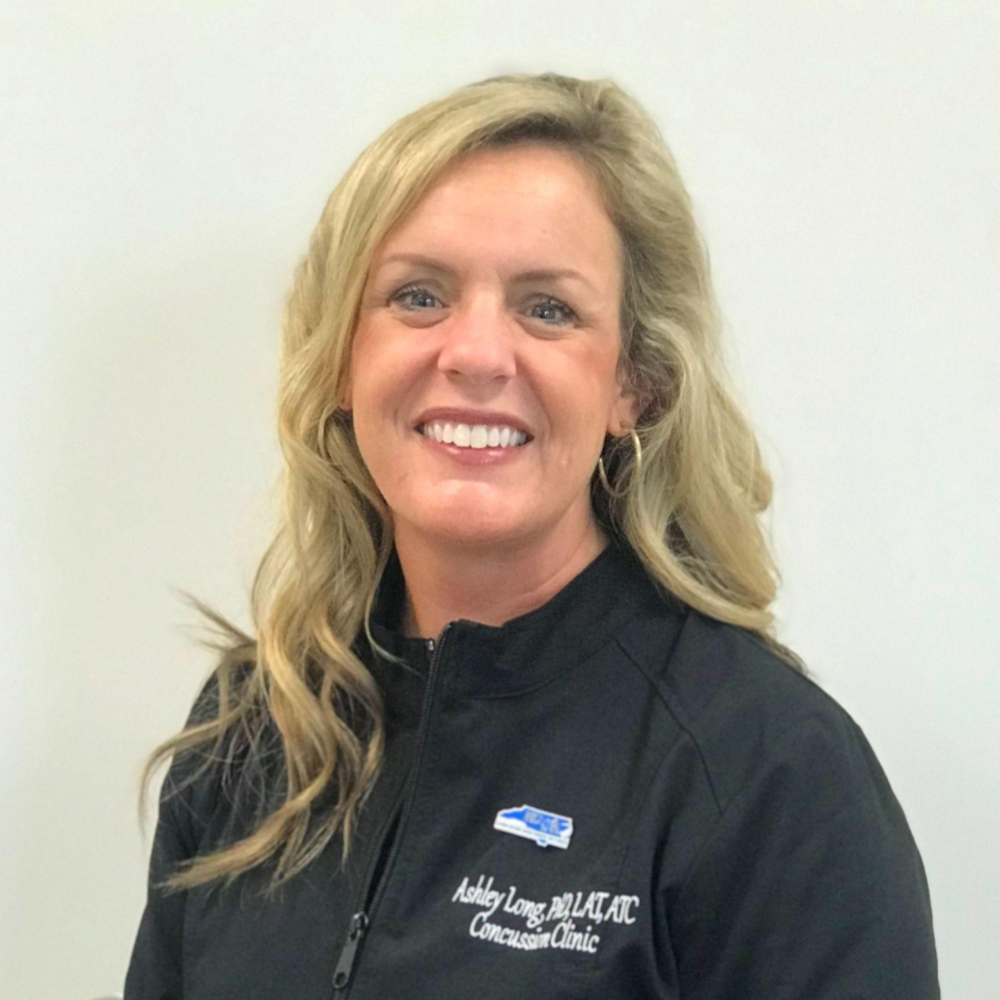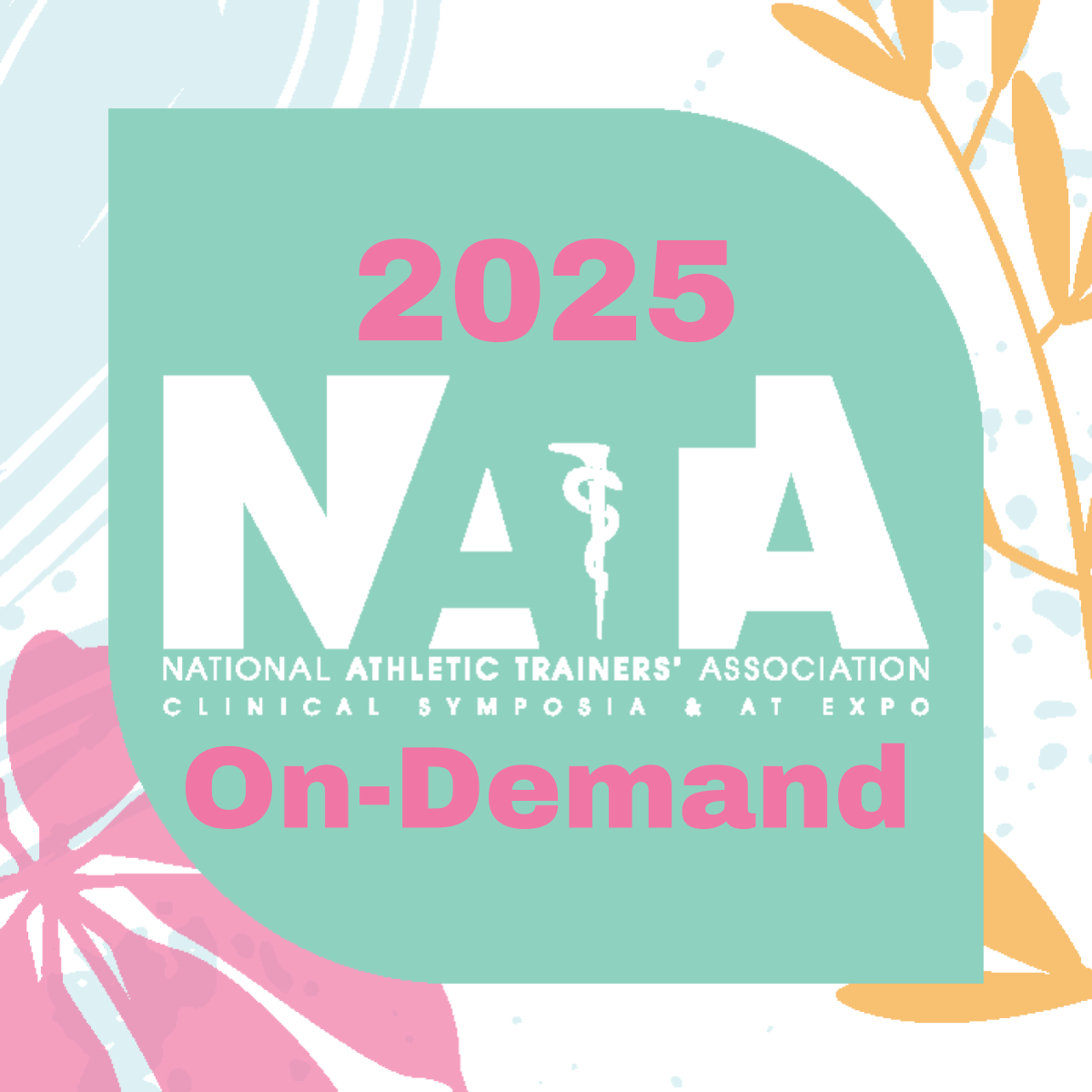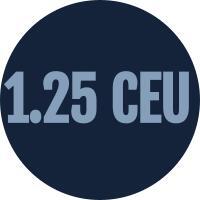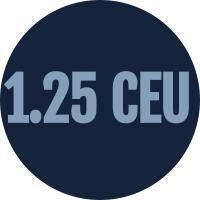
Catalog Advanced Search
-
Get ready for an unparalleled educational journey designed to inspire, educate and empower. This year, we are proud to present a robust program featuring the latest innovations, expert-led sessions and a variety of learning formats tailored to meet your professional development needs. Our speakers include leading experts and innovators in the field, delivering relevant and impactful content you can apply in your practice. Don’t miss this opportunity to stay at the forefront of athletic training education. The On-Demand program will feature select recorded sessions from the NATA 2025 in-person convention in Orlando, FL, taking place from June 24 to June 27. Program sessions and details are subject to change.
Welcome to the 76th NATA Clinical Symposia On-Demand Education Experience!
Get ready for an unparalleled educational journey designed to inspire, educate and empower. This year, we are proud to present a robust program featuring the latest innovations, expert-led sessions and a variety of learning formats tailored to meet your professional development needs. Our speakers include leading experts and innovators in the field, delivering relevant and impactful content you can apply in your practice. Don’t miss this opportunity to stay at the forefront of athletic training education.
Earn up to a Maximum of 20 CEUs.
On-Demand Only registrants can earn a maximum of 20 CEUs. In order to earn your CEUs, you must watch the session video in its entirety and complete the assessment.
In-person attendees can earn a maximum of 20 CEUs: Up to 15 on-site in Orlando and the rest – up to 20 total - from NATA 2025 On-Demand. In order to earn your on-demand CEUs, you must watch the session video in its entirety and complete the assessment. Interested in joining us in Orlando? View the 76th NATA Clinical Symposia & AT Expo event page.
The On-Demand program will feature select recorded sessions from the NATA 2025 in-person convention in Orlando, FL, taking place from June 24 to June 27. Program sessions and details are subject to change.-
Register
- Non-member - $930
- Member - $595
- Student - $155
- Certified Student - $445
- Retired - Free!
- More Information
-
Register
-
The use and abuse of opioids within the United States is at crisis levels and has been declared a public health emergency by the U.S. Department on Health and Human Services in 2017. 130 Americans die every day from an opioid overdose and 11.4 million people misuse prescription opioids per year. The population of patients that athletic trainers work with daily is frequently prescribed opioids for pain management and are therefore an at risk population for opioid overdose. Naloxone can reverse the life-threatening respiratory depression associated with the opioid overdose, and athletic trainers, physician, EMS personnel, allied health professionals, and others must be knowledgeable in the most current…
Abstract:
The use and abuse of opioids within the United States is at crisis levels and has been declared a public health emergency by the U.S. Department on Health and Human Services in 2017. 130 Americans die every day from an opioid overdose and 11.4 million people misuse prescription opioids per year. The population of patients that athletic trainers work with daily is frequently prescribed opioids for pain management and are therefore an at risk population for opioid overdose. Naloxone can reverse the life-threatening respiratory depression associated with the opioid overdose, and athletic trainers, physician, EMS personnel, allied health professionals, and others must be knowledgeable in the most current recommendations and evidence regarding the prevention, recognition, and management of a patient in opioid overdose with naloxone, and must be able to bridge the gap between current evidence and knowledge and clinical competency and/or performance for professionals with regards to prevention, recognition, management, and recovery from opioid addiction.
Objectives:- Participants will be able to explain how a prehospital interprofessional healthcare team works collaboratively to improve patient outcomes.,
- Participants will be able to identify the current NATA and EMS recommendations regarding the prehospital management of the opioid overdose patient.,
- Participants will be able to identify opioids and drugs that increase overdose risk.,
- Participants will be able to identify and discuss myths and facts relative to opioids, overdoses, and overdose management.,
- Participants will be able to examine and discuss the current scientific evidence related to the opioid epidemic specifically focusing on (1) epidemiology; (2) at risk populations; (3) overdose prevention strategies; and (4) naloxone distribution programs.,
- Participants will be able to define, discuss, and differentiate the indications, contraindications, and mechanism of action of naloxone.,
- Participants will be able to describe and demonstrate skills needed for (1) effective management of airway, breathing, and circulation in the opioid overdose patient; and (2) the administration of naloxone.,
- Participants will be able to demonstrate the proper sequence and implementation of critical decision-making skills and the current evidence.,
- Participants will be able to understand state legislation pertaining to prevention strategies & naloxone.
Level:
Advanced
Domains:
Domain 1: Risk Reduction Wellness and Health Literacy
Domain 2: Assessment Evaluation and Diagnosis
Domain 4: Therapeutic Intervention
Domain 5: Health Care Administration and Professional ResponsibilityCEUs: 1.0 Category A
Keywords: addiction, life saving medication, overdose, mental health, opioid, drug use, naloxone
On-Demand (Enhanced Access) Course Expiration:
Courses registered for after February 5, 2025, must be completed by December 31, 2025, at 11:59 p.m. CST.
For full details, refer to the expiration policy on our FAQ page.
Darryl Conway, MA, LAT, ATC
Darryl Conway serves as the Senior Associate Athletic Director & Chief Health & Welfare Officer for University of Michigan Athletics, owner of Conway Ventures, LLC, and is Co‐Founder / Partner of Sports Medicine Emergency Management, LLC (SMEM). Darryl holds a Masters’ Degree from Adelphi University (’95) in Sports Medicine and Sports Management and a Bachelors’ Degree from the University of Delaware (’93) in Physical Education Studies and Athletic Training. In addition to being a certified member of the National Athletic Trainers’ Association (NATA), Darryl has worked with various SWAT Teams as their Tactical Medic and Athletic Trainer, and as a volunteer EMT, and has been an American Red Cross first aid, CPR, and AED instructor for 30 years. Darryl serves as the Chair of the NATA’s Ethnic Diversity Advisory Committee (EDAC), is a member of the NATA’s Diversity, Equity, Inclusion, & Advocacy (DEIA) Task Force, Michigan Athletic Trainers’ Society (MATS) Diversity, Equity, & Inclusion Committee, Michigan Athletic Trainers’ Society (MATS) AT Cares Committee, NATA Research & Education Foundation (REF) Development Task Force, & the NATA’s Educationalist Community Diversity Recruitment & Retention Work Group. Darryl served as Co‐Chair of the NCAA’s Diverse Student‐Athlete Mental Health & Well‐Being Task Force, is a member of the State of Michigan Board of Athletic Trainers, the State of Michigan Board of Athletic Trainers Disciplinary Sub‐Committee & Rules Sub‐Committee, the Board of Certification of Athletic Trainers (BOC) Reinstatement Committee, and previously served on the NATA Committee on Professional Ethics (COPE). Darryl also serves as an Instructor Trainer for American Red Cross CPR / AED / First Aid Instructor Courses, an Associate Expert with The Rehberg‐Konin Group, an Instructor & Ambassador with Stop the Bleed, and has worked as an Athletic Trainer at the Winter X Games and various Red Bull extreme events. Darryl was also a member of the Spine Injury in Sports Group (SISG), is a member of the Xenith Scientific Advisory Committee, and a consultant for RG Medical Diagnostics. Darryl was named as a Distinguished Athletic Trainer by the Michigan Athletic Trainers’ Society (MATS) in 2022, a Most Distinguished Athletic Trainer by the National Athletic Trainers’ Association (NATA) in 2019 and was recognized by the College Athletic Trainers’ Society (CATS) in 2018 with the prestigious Quality of Life Award.
-
Register
- Non-member - $25
- Member - Free!
- Student - Free!
- Staff - Free!
- Certified Student - Free!
- Retired - $15
- More Information
-
Pitching is the fastest and most stressful motion the human body can produce. These large and repetitive forces lead to motion and strength deficits throughout the body, which can alter normal mechanics. This compensation is often missed since performance is not initially affected; however, the athlete is often at an increased risk of injury. As a clinician, it is essential to understand normal mechanics and the best way to assess without sophisticated motion analysis systems. In addition, clinicians need to know the components of a thorough kinetic chain assessment and most importantly how to integrate both into a comprehensive program.
Abstract:
Pitching is the fastest and most stressful motion the human body can produce. These large and repetitive forces lead to motion and strength deficits throughout the body, which can alter normal mechanics. This compensation is often missed since performance is not initially affected; however, the athlete is often at an increased risk of injury. As a clinician, it is essential to understand normal mechanics and the best way to assess without sophisticated motion analysis systems. In addition, clinicians need to know the components of a thorough kinetic chain assessment and most importantly how to integrate both into a comprehensive program.
Objectives:- Participants will be able to learn normal pitching mechanics and how to assess clinically.,
- Participants will be able to learn the common kinetic chain deficits in the baseball player.,
- Participants will be able to learn to perform a thorough full body kinetic chain assessment specific to baseball player.,
- Participants will be able to learn to develop a comprehensive program that integrates both pitching mechanics and kinetic chain deficit.
Level:
Advanced
Domains:
Domain 1: Risk Reduction Wellness and Health Literacy, Domain 2: Assessment Evaluation and Diagnosis, Domain 4: Therapeutic InterventionCEUs: 1.25 Category A
Keywords: elbow, shoulder, baseball, pitching, injury, kinetic chain,
On-Demand (Enhanced Access) Course Expiration:
Courses registered for after February 5, 2025, must be completed by December 31, 2025, at 11:59 p.m. CST.
For full details, refer to the expiration policy on our FAQ page.
Stephen J. Thomas, PhD, ATC, FNATA
Stephen Thomas is an Associate Professor and Chair of the Exercise Science Department at Thomas Jefferson University. He completed his undergraduate and master’s degree in Kinesiology, at Temple University. He then earned his Ph.D. in Biomechanics & Movement Science at the University of Delaware. Dr. Thomas received an NIH F32 postdoctoral research fellowship in the bioengineering of tendon at the McKay Orthopaedic Research Laboratory at the University of Pennsylvania. Dr. Thomas has research expertise in the adaptation of tissues to stress and overuse specifically at the shoulder. He is the current President of the American Society of Shoulder and Elbow Therapists. He is also a consultant for the Philadelphia Phillies and the Penn Throwing Clinic. His training in both basic science and applied research methods allows him to address clinically relevant questions with translation approaches thereby bridging the gap between bench and bedside. His initial work has contributed to the understanding of tissue adaptations in throwing athletes and how they relate to overuse shoulder injuries using novel diagnostic ultrasound methods. In addition, his basic science work studying the tissue and biologic adaptations to chronic rotator cuff tears and the effects of type II diabetes has also helped progress the current field. His current research agenda is two-fold and includes integration of translational research to investigate 1) the structural and biologic mechanisms governing soft tissue adaptation caused by the repetitive stress of throwing and the association with throwing biomechanics and 2) the structural, neuromuscular, and biologic adaptations occurring due to chronic rotator cuff tears and repairs.
-
Register
- Non-member - $31.25
- Member - Free!
- Student - Free!
- Staff - Free!
- Certified Student - Free!
- Retired - $18.75
- More Information
-
Adverse Childhood Experiences (ACEs) are traumatic events that occur during childhood, including exposure to violence, abuse, substance use, mental health issues, and parental separation. ACEs can negatively impact mental and physical health in adulthood. 64% of adults report > 1 ACE and 20% report > 3. The impact of ACEs can be mitigated with connection to supportive adults and positive activities that promote social-emotional learning and coping. Athletic trainers are uniquely positioned to support individuals who have experienced ACEs by assessing mental health, developing a robust referral network, and providing trauma-informed care.
This is an encore presentation from NATA 2022 in Philadelphia, offering a second chance to experience the event's valuable content and insights.
Abstract:
Adverse Childhood Experiences (ACEs) are traumatic events that occur during childhood, including exposure to violence, abuse, substance use, mental health issues, and parental separation. ACEs can negatively impact mental and physical health in adulthood. 64% of adults report > 1 ACE and 20% report > 3. The impact of ACEs can be mitigated with connection to supportive adults and positive activities that promote social-emotional learning and coping. Athletic trainers are uniquely positioned to support individuals who have experienced ACEs by assessing mental health, developing a robust referral network, and providing trauma-informed care.Learning Objectives:
- Define ACEs and their impact on mental and physical health
- Implement a trauma-informed approach to the roles and responsibilities of athletic training
- Develop a compendium of developmentally appropriate trauma-informed resources, referrals, and brief interventions
Level:
EssentialDomain(s):
Domain 1: Risk Reduction Wellness and Health LiteracyCEUs:
1.0 Category AKeywords: Biopsychosocial, trauma-informed, patient-centered
On-Demand (Enhanced Access) Course Expiration:
Courses registered for after February 5, 2025, must be completed by December 31, 2025, at 11:59 p.m. CST.
For full details, refer to the expiration policy on our FAQ page.
Ashley Long, PhD, LAT, ATC
As the Concussion Clinic Coordinator at Mt. Olive Family Medicine Center, I oversee the delivery of comprehensive concussion services to the eastern North Carolina community. With over 20 years of experience as a Certified Athletic Trainer and an ImPACT Trained Athletic Trainer, I am passionate about providing evidence-based assessment, management, and education for concussion patients and their families.
In addition to my clinical role, I am also an Adjunct Professor at The University of Georgia, where I teach a graduate course in Healthcare Management for Athletic Training students. I hold a PhD in Kinesiology and Exercise Science from the University of Mississippi, and am working toward a Certificate in Biomedical Neuroscience from the University of Florida. I am also the owner and clinician of NeuroActive, LLC, a concussion assessment and education company. I have received multiple honors and awards for my research and service in the field of concussion and athletic training, and I am committed to advancing the knowledge and practice of concussion care in rural settings.
Allison Bickett, PhD
Dr. Allison Bickett received her PhD in Clinical Health Psychology at the University of North Carolina at Charlotte, and a Master’s Degree in Applied Cognition and Neuroscience from the University of Texas at Dallas. She presently serves as the Director of Behavioral Medicine Education in the Department of Family Medicine. She is responsible for Behavioral Health Integration programs at the three Family Medicine residency sites; supporting patient care in the inpatient and outpatient setting, as well as Diabetes and HIV clinics. Allison assists in developing and teaching the Longitudinal Behavioral Medicine curriculum; supporting and evaluating residents in the advancement of their mental health knowledge and clinical interviewing skills. Core facets of the Behavioral Medicine curriculum include motivational interviewing, active listening and the outpatient management of mental health issues commonly seen in primary care. Allison’s research interests include the relationship between mental health and chronic illness, behavioral health integration and mental health screening in the community.
Allison serves on several committees and taskforces to address physician well-being, and one of her passions in this area is the intersection of medicine and the humanities. She co-facilitates the Art of Medicine program, which is a unique collaboration between Atrium Health and the Bechtler Museum of Modern Art, which allows physicians and APPs to explore important works of art and process the challenging emotions that arise from the practice of medicine.-
Register
- Non-member - $25
- Member - Free!
- Student - Free!
- Staff - Free!
- Certified Student - Free!
- Retired - $15
- More Information
-
What is the implication for risk and safety if 95% of all that humans do is unconscious and socially influenced? No matter how many safety policies, safety signs, stretch programs or injury prevention programs we have, the potential for an employee to be injured on the job will still exist. Holistic approaches, such as the Total Worker Health approach, prioritizes a hazard-free work environment for all workers. It also brings together all aspects of work in integrating interventions that address worker safety, health and well-being. Using a holistic approach to injury prevention can help reduce injury risk by...
This presentation is a replay from COPA Con 2023, providing another opportunity to access its valuable content and insights.
Abstract:
What is the implication for risk and safety if 95% of all that humans do is unconscious and socially influenced? No matter how many safety policies, safety signs, stretch programs or injury prevention programs we have, the potential for an employee to be injured on the job will still exist. Holistic approaches, such as the Total Worker Health approach, prioritizes a hazard-free work environment for all workers. It also brings together all aspects of work in integrating interventions that address worker safety, health and well-being. Using a holistic approach to injury prevention can help reduce injury risk by identifying and addressing underlying psychosocial issues that employees face either as a result of their work environment or life outside of work. An athletic trainer can play a pivotal role in injury risk reduction when additional focus is placed on overall health and wellness in the workplace.Learning Objectives:
- Explain how a holistic health and wellness approach applies to injury prevention.
- Identify psychosocial components of work and life that impact employee’s overall health and wellness.
- Identify options for determining worker health and wellness in the occupational setting.
- Explain ways to improve overall health and wellness as an athletic trainer in the occupational setting.
Level:
AdvancedDomain(s):
Domain 1: Risk Reduction Wellness and Health Literacy
Domain 5: Health Care Administration and Professional ResponsibilityCEUs:
1.0 Category AKeywords: holistic, wellness, occupational, injury prevention
Enhanced Access On-Demand Course Expiration:
This course will expire on December 31 at 11:59 p.m. CST and will be removed from your account if not completed.
For full details, refer to the expiration policy on our FAQ page.
Jillian Nicholson, LAT, CEAS, AEP
Jillian Nicholson, LAT, CEAS, AEP, launched Up North Injury Prevention & Ergonomics in 2022 to provide high quality injury prevention services to companies in Northern Wisconsin. Jillian is an experienced Industrial Athletic Trainer with additional background in Ergonomics and Total Worker Wellness. Her AT background includes experience in occupational medicine, employer-based clinics, orthopedics and physical medicine settings, and she is skilled in Ergonomics, Injury Prevention, and Sports Medicine.
Jillian earned her Bachelor's of Science focused in Athletic Training from Northern Michigan University, Associate Ergonomics Professional Certification through BCPE and working is towards becoming a Certified Professional Ergonomist.
-
Register
- Non-member - $25
- Member - Free!
- Student - Free!
- Staff - Free!
- Certified Student - Free!
- Retired - $15
- More Information
-
The area of psychosocial intervention and referral in athletic training is especially problematic for both athletic training educators and their students. Recent consensus statements have detailed the importance of emergent mental health referrals in both high school and collegiate settings. However, research suggests that athletic trainers are comfortable knowing when to refer but are not comfortable with the actual act of approaching an athlete for referral. Teaching these skills with appropriate practical follow-up is difficult because there are, understandably, limited practice opportunities for student skill development in the clinical setting. In order to be effective…
This presentation is a replay from 2019 NATA Athletic Training Educators' Conference, offering a second chance to experience the event's valuable content and insights.
Abstract:
The area of psychosocial intervention and referral in athletic training is especially problematic for both athletic training educators and their students. Recent consensus statements have detailed the importance of emergent mental health referrals in both high school and collegiate settings. However, research suggests that athletic trainers are comfortable knowing when to refer but are not comfortable with the actual act of approaching an athlete for referral. Teaching these skills with appropriate practical follow-up is difficult because there are, understandably, limited practice opportunities for student skill development in the clinical setting. In order to be effective, educational strategies must extend beyond lectures and focus on the psychomotor skills and abilities to help foster positive communication which leads to adequate referral. Further, the education must go beyond the signs and symptoms of specific mental health issues and focus on appropriate intervention for a person in crisis (regardless of underlying condition). The purpose of this presentation is to present a course module, developed jointly by a licensed professional counselor and an athletic trainer, with these skills and abilities in mind. The presentation will present the components of the entire module including course content materials, activities used to teach the appropriate skills and all grading documents that have been developed an actual recorded video of student interactions in a role-play situation along with rubrics developed for grading intervention behaviors will be shared.
Objectives:- Participants will be able to identify the anatomy of a referral session for an athlete in crisis.,
- Participants will be able to identify appropriate communication strategies to use during a crisis intervention.,
- Participants will be able to identify important body language necessary to foster an appropriate rapport with the athlete.,
- Participants will be able to evaluate a video of a mocked referral session using assessment rubrics to provide feedback.,
- Participants will be able to identify common errors that students make when attempting these skills.
Level:
Essential
Domains:
Domain 2: Assessment Evaluation and DiagnosisCEUs: 0.75 Category A
Keywords: mental health, students, crisis, intervention, psychosocial
On-Demand (Enhanced Access) Course Expiration:
Courses registered for after February 5, 2025, must be completed by December 31, 2025, at 11:59 p.m. CST.
For full details, refer to the expiration policy on our FAQ page.
Angela Mickle, PhD, ATC
Angela Mickle has served as a member of the athletic training faculty at Radford University since 2001. She is teaches a wide variety of courses in the Athletic Training program and has developed an interprofessional curriculum in psychosocial interventions. Her primary areas of interest are acute and chronic pain management, organization and administration and team based learning.
Nadine Hartig, PhD, LCSW, LPC
Nadine Hartig is a Licensed Professional Counselor (VA) and a Licensed Clinical Social Worker (CO). She holds a master’s degree in social work from the University of Wisconsin-Madison (1996) and a doctorate in Counselor Education and Supervision from the University of Northern Colorado (2004). She is a registered play therapist (RPT), Board Certified Tele-mental Health practitioner, and EMDRIA trained in EMDR.
She has over twenty-five years of clinical experience in a variety of settings, including universities, community mental health centers, K-12 schools, crisis settings, private practice, the State Public Defender’s Office, domestic violence and trauma centers, integrated behavioral health, and dual diagnosis treatment. She has been part of Radford University’s faculty since 2006, where she holds rank as Professor and serves as the chairperson of the Department of Counselor Education. She also serves as the Director for the Center of Integrated Health and Wellness.
She has taught across the counseling core, school counseling, couples and family counseling, and clinical mental health curricula for over fifteen years. Her areas of interest include trauma treatments, counseling children and adolescents, integrated health, wellness, supervision, leadership, sport performance, and career development.
-
Register
- Non-member - $18.75
- Member - Free!
- Student - Free!
- Staff - Free!
- Certified Student - Free!
- Retired - $11.25
- More Information
-
The purpose of this presentation is to examine and discuss current and emerging liability exposures confronting athletic training professionals. Our goal is to help athletic trainers understand their major areas of vulnerability and take appropriate action to protect their patients from harm and themselves and their employers from potential litigation. This presentation will feature claim scenarios and high-level risk control recommendations which, if implemented appropriately, can help prevent incidents and increase patient satisfaction while minimizing exposure to lawsuits and licensure/certification actions.
Abstract:
The purpose of this presentation is to examine and discuss current and emerging liability exposures confronting athletic training professionals. Our goal is to help athletic trainers understand their major areas of vulnerability and take appropriate action to protect their patients from harm and themselves and their employers from potential litigation. This presentation will feature claim scenarios and high-level risk control recommendations which, if implemented appropriately, can help prevent incidents and increase patient satisfaction while minimizing exposure to lawsuits and licensure/certification actions.Objectives:
- Participant will be able to understand the most common claims of negligence made against Athletic Trainers in malpractice lawsuits.,
- Participant will be able to understand the most common patient injuries in malpractice lawsuits.,
- Participant will be able to identify key risk management tools Athletic Trainers can incorporate into their practice.
Level:
Essential
Domains:
Domain 5: Health Care Administration and Professional ResponsibilityCEUs: 1.25 Category A
Keywords: legal, law, malpractice, risk management, negligence, liability, leadership,
On-Demand (Enhanced Access) Course Expiration:
Courses registered for after February 5, 2025, must be completed by December 31, 2025, at 11:59 p.m. CST.
For full details, refer to the expiration policy on our FAQ page.
Jennifer Flynn, CPHRM
Jennifer Flynn, CPHRM, is Vice President of Risk Management for Nurses Service Organization in the Healthcare Division of Aon’s Affinity Insurance Services, Inc. Specializing in risk management and having worked in the health care insurance business for over 21 years, Jennifer is dedicated to educating nurses and health care professionals on professional liability risks and offers strategies to mitigate those risks by supporting patient safety principles and developing quality management programs. In addition to being a frequent national speaker on healthcare risk and liability, Jennifer is also a published author on various risk management topics. Jennifer is a Certified Professional in Healthcare Risk Management and is a licensed Property & Casualty agent. She earned a BA in Psychology from Arcadia University in Glenside, Pennsylvania.

Lynn Pierce, BSN, RN, CPHRM
Lynn Pierce, BSN, RN, CPHRM, is a risk control director for CNA Healthcare. Prior to joining CNA, she worked in such clinical settings as emergency, surgical and cardiac critical care, and cardiac and orthopedic rehabilitation services. She has served as a director of risk management in acute care hospitals and integrated health care systems and has held leadership positions in risk management, quality, HIPAA privacy, environmental and patient safety, case management, corporate compliance, Workers’ Compensation and infection prevention. In 2002, she became a certified legal nurse consultant. She earned her BSN from the University of West Georgia in Carrollton, Georgia.
-
Register
- Non-member - $31.25
- Member - Free!
- Student - Free!
- Staff - Free!
- Certified Student - Free!
- Retired - $18.75
- More Information
-
There are over 100 different physical examination tests described to evaluate the shoulder. Confusion exists with regard to not only the proper technique but the validity of commonly used tests. In today's fast paced environment evidence based accuracy and efficiency when examining athletes is very important. This presentation will review the proper technique and statistical validation, and relevance of the best tests based on current literature. The discussion will include a demonstration of an efficient sequence and algorithm incorporating all necessary tests to complete a thorough and comprehensive examination of the shoulder.
Abstract:
There are over 100 different physical examination tests described to evaluate the shoulder. Confusion exists with regard to not only the proper technique but the validity of commonly used tests. In today's fast paced environment evidence based accuracy and efficiency when examining athletes is very important. This presentation will review the proper technique and statistical validation, and relevance of the best tests based on current literature. The discussion will include a demonstration of an efficient sequence and algorithm incorporating all necessary tests to complete a thorough and comprehensive examination of the shoulder.
Objectives:- Participants will be able to describe the history and proper indications for the most commonly used shoulder exam tests.,
- Participants will be able to explain basic statistical terms (i.e., sensitivity, specificity, diagnostic accuracy) to describe the validity of physical exam tests.,
- Participants will be able to describe the proper technique for performing shoulder exam tests.
Level:
Advanced
Domains:
Domain 2: Assessment Evaluation and DiagnosisCEUs:
0.75 Category AKeywords: shoulder, examination, tests, diagnostic, pitching, throwing,
On-Demand (Enhanced Access) Course Expiration:
Courses registered for after February 5, 2025, must be completed by December 31, 2025, at 11:59 p.m. CST.
For full details, refer to the expiration policy on our FAQ page.Please note: This course will be retired from our catalog after December 31, 2025, and its content will no longer be accessible. Be sure to download any necessary handouts before this date. Your statement of credit will remain available on the Transcript page, accessible via the left sidebar menu.

Steve Jordan, MD
Dr. Steve Jordan is a board certified, fellowship trained orthopaedic surgeon. Dr. Jordan earned his Medical Degree from Medical University of South Carolina. Dr. Jordan specializes in sports medicine; however, he takes a special interest in shoulder injuries, throwing injuries, ACL reconstruction, and Tommy John reconstruction. Dr. Jordan is the Team Physician for both Washington High School and Chipola College.
-
Register
- Non-member - $18.75
- Member - Free!
- Student - Free!
- Staff - Free!
- Certified Student - Free!
- Retired - $11.25
- More Information
-
Ankle impingement is a problem that involves compression of soft/bony tissue with ankle motion. Impingement can be a significant problem for individuals impacting normal motion and leading to compensatory adaptations. This presentation will review ankle anatomy, common causes of impingement, imaging options, and treatment considerations.
Abstract:
Ankle impingement is a problem that involves compression of soft/bony tissue with ankle motion. Impingement can be a significant problem for individuals impacting normal motion and leading to compensatory adaptations. This presentation will review ankle anatomy, common causes of impingement, imaging options, and treatment considerations.
Objectives:- Participants will be able to identify signs and symptoms of ankle impingement.,
- Participants will be able to describe considerations for imaging.,
- Participates will be able to outline treatment options for athletes with ankle impingement.
Level:
Essential
Domains:
Domain 2: Assessment Evaluation and Diagnosis, Domain 4: Therapeutic InterventionCEUs:
0.75 Category AKeywords: ankle impingement, treatment, imaging, motion, compression
On-Demand (Enhanced Access) Course Expiration:
Courses registered for after February 5, 2025, must be completed by December 31, 2025, at 11:59 p.m. CST.
For full details, refer to the expiration policy on our FAQ page.
Eric Nussbaum, MEd, ATC, LAT
Eric Nussbaum is an athletic trainer at University Orthopaedic Associates with 30+ years of experience in all levels of athletics. He received a graduate degree in athletic training from the University of Virginia in Charlottesville, VA as well as an undergraduate degree from Millersville University of Pennsylvania in Millersville, PA.
Accomplishments
- Extensive experience in athletic training for both amateur and professional teams
- Amateur: Hillsborough High School, Rutgers University, Team USA, Men’s Lacrosse Team, University of Virginia, and at the Lake Placid Olympic Training Center
- Professional: Philadelphia Eagles
- Clinical Instructor, Department of Orthopaedic Surgery, Rutgers – Robert Wood Johnson Medical School
- Current Athletic Trainer at Colts Neck High School
- Past President of Athletic Trainers’ Society of New Jersey (ATSNJ)
- Member of Athletic Trainers’ Society of New Jersey (ATSNJ) Hall of Fame
- Member NJSCA Hall of Fame (NJ State Coaches Association)
- Speaker at numerous national, regional, state and local meetings
- Published author of multiple journal articles and book chapters
- Past Executive Committee Member of National Athletic Trainers’ Association (NATA), District 2
- Received multiple distinguished service awards
- Founding Member of the College Athletic Trainers Society
- Involved with new research on high ankle sprains and adolescent overuse injury
-
Register
- Non-member - $18.75
- Member - Free!
- Student - Free!
- Staff - Free!
- Certified Student - Free!
- Retired - $11.25
- More Information
-
Evidence-based practice compels clinicians to challenge existing paradigms, especially when desired outcomes remain elusive. Insidious lateral knee pain involving the iliotibial band (ITB) in running based athletes has been conceptualized as ITB friction syndrome, an unsubstantiated clinical paradigm based on Renne's 1975 theory that the ITB rolls over the lateral femoral epicondyle during repetitive flexion/extension movements, irritating the ITB and underlying bursa. Contemporary anatomical, biomechanical, and interventional evidence directly challenges this long-held paradigm. Given this new evidence, ITB Impingement Syndrome is presented as a more robust, evidence-informed paradigm for evaluating and treating problematic ITB related pathologies.
Abstract:
Evidence-based practice compels clinicians to challenge existing paradigms, especially when desired outcomes remain elusive. Insidious lateral knee pain involving the iliotibial band (ITB) in running based athletes has been conceptualized as ITB friction syndrome, an unsubstantiated clinical paradigm based on Renne´s 1975 theory that the ITB rolls over the lateral femoral epicondyle during repetitive flexion/extension movements, irritating the ITB and underlying bursa. Contemporary anatomical, biomechanical, and interventional evidence directly challenges this long-held paradigm. Given this new evidence, ITB Impingement Syndrome is presented as a more robust, evidence-informed paradigm for evaluating and treating problematic ITB related pathologies.
Objectives:- Participants will be able to distinguish between the existing and widely held paradigm for ITB pain and dysfunction known as iliotibial friction syndrome and the newly proposed iliotibial band impingement syndrome.,
- Participants will be able to evaluate athletes presenting with ITB impingement syndrome, based on a new biomechanically based and evidence-informed model of assessment that focuses on deficient hip muscle function.,
- Participants will be able to design and implement more effective, evidence-informed treatment programs for athletes suffering from ITB impingement syndrome by focusing on greater closed chain gluteal muscle function and timing.
Level:
Advanced
Domains:
Domain 1: Risk Reduction Wellness and Health Literacy, Domain 2: Assessment Evaluation and Diagnosis, Domain 4: Therapeutic InterventionCEUs: 1.0 Category A
Keywords: knee, iliotibial band, ITB, impingement, bursa, running,
On-Demand (Enhanced Access) Course Expiration:
Courses registered for after February 5, 2025, must be completed by December 31, 2025, at 11:59 p.m. CST.
For full details, refer to the expiration policy on our FAQ page.
Paul Geisler, EdD, AT Ret.
Associate Dean Geisler is a native of Lakeville, MA and current resident of Boston, MA. A certified athletic trainer since 1987 with over 15 years of varied clinical practice and 23 years' experience directing athletic training education programs at Georgia Southern University and Ithaca College. He is deeply interested in the development and assessment of the medico-clinical thinking processes of novice and experienced clinicians, the development of adaptive expertise in clinicians, progressive curriculum design, capability-based education, and meaningful programmatic assessment. He has over 170 national and international presentations and publications on clinical and educational based subjects in athletic training and health professions education to his credit. He is a member of the European Board of Medical Assessors, and past member of the Association of Medical Education, Europe.
As a scholar, he is the recipient of two manuscript awards from the Journal of Athletic Training and the Athletic Training Education Journal. For his many professional contributions, he has been the recipient of the NATA Athletic Training Service Award and NATA Most Distinguished Athletic Trainer Award. As an educator, he was awarded the NATA Executive Council on Education's Sayers "Bud" Miller Distinguished Educator Award in 2021 and has received two Dean's Awards for Excellence & Innovation in Teaching, a Dean's Excellence Award for Diversity and Inclusion in Teaching and Learning, and the all college Faculty Excellence Award, all from Ithaca College.
He admits to being an enthusiastic but slow road cyclist, an amateur shutterbug of nature and wonder, an aspiring wine snob and amateur foodie, and an unabashed promoter of equal rights, freedom, justice, and authentic democracy for all living beings. Susan, his life partner and wife of 34 years and he are fulfilled parents of two amazing young men – Nicholas, a writer living in Los Angeles, CA and Benjamin, a photographer and artist living in Brooklyn, NY.
-
Register
- Non-member - $25
- Member - Free!
- Student - Free!
- Staff - Free!
- Certified Student - Free!
- Retired - $15
- More Information










